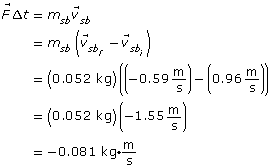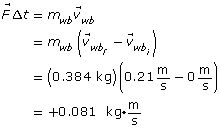Module 2
1. Module 2
1.15. Page 6
Module 2—The Conservation of Momentum in Isolated Systems
 Reflect and Connect
Reflect and Connect
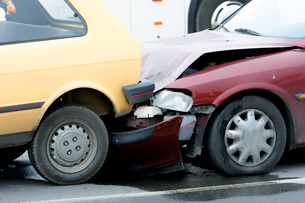
© Aleksandar Kamasi/shutterstock
In the Get Focused section of this lesson, you were asked this question: in a collision between two automobiles, is it better for the occupants if the collision is elastic or inelastic?
Now that you know the differences between elastic and inelastic collisions, you should be ready to complete the necessary analysis to answer this question. A good place to begin is the collision between the ball pendulum and the block pendulum for which you designed an experiment in A 3.
In one version of this experiment, a bouncy ball attached to a long string collides with a wooden block that is also suspended by a long string. In other words, a bouncy-ball pendulum collides with a wooden-block pendulum. Before the collision, the bouncy ball has all the kinetic energy because the wooden block is at rest. After the collision, both objects have some kinetic energy.
The following diagram summarizes typical results:

In another version of this experiment, the bouncy ball is replaced with a ball of clay. Before the collision, the ball of clay has all the kinetic energy because the block of wood is at rest. After the collision, both objects have some kinetic energy. The following diagram summarizes typical results:

The results for the pendulum experiment illustrate how the properties of the materials impact the transfer of kinetic energy in a collision. Some of the initial kinetic energy was used to do work to change the shape of the clay ball, so there was less kinetic energy available for the objects after the collision.
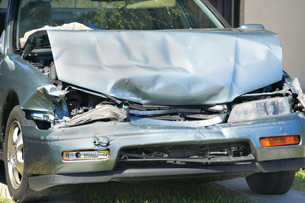
© felix casio/shutterstock
An automobile collision is more like the collision between the clay ball and the block than the bouncy ball and the block. Some of the initial kinetic energy is used to do work to change the shape of the crumple zones of the vehicle. The amount of kinetic energy transferred from one vehicle to the other depends upon the amount of work that is done to change the shape of the vehicles. Although this energy transfer has nothing to do with impulse, the resulting impulse that acts on each vehicle in a collision is strongly influenced by how the transfer of kinetic energy occurs between the two vehicles. You can see why by returning to typical data from the experiments of the two pendulums.
In the case of the bouncy ball and the wooden block, typical data for the collision is shown in the following diagram:

bouncy ball
|
← Before the collision →
← After the collision → |
wooden block
|
Determine the impulse that acted on the bouncy ball:
|
Determine the impulse that acted on the wooden block:
|
As you can see, the impulse for each has the same magnitude but opposite direction.
When a clay ball collides with a wooden block, the velocity values are significantly reduced due to the lower values of kinetic energy. The following diagram shows typical results:

clay ball
|
← Before the collision →
← After the collision → |
wooden block
|
Determine the impulse that acted on the clay ball:
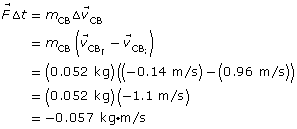
Determine the impulse that acted on the wooden block:
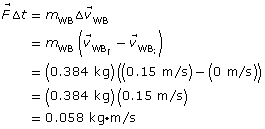
 Self-Check
Self-Check
SC 6. Explain why it would be better to be in a vehicle that is in an inelastic collision with another object rather than a vehicle in an elastic collision with another object.
 Self-Check Answers
Self-Check Answers
SC 6. Inelastic collisions involve a significant reduction in the kinetic energy of the objects after the collision since very little bouncing or reversal of direction occurs. This means that the overall change in velocity is less, so the change in momentum is less. Therefore, less impulse is required to cause that change in momentum. In addition, the time interval for the inelastic collision is increased because crumpling takes time. As was mentioned in the previous module, if the time interval for an interaction lengthens, then the force required reduces to achieve the same impulse.
 Reflect on the Big Picture
Reflect on the Big Picture
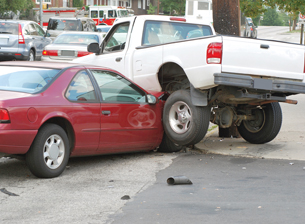
© Katherine Welles/shutterstock
Recall the collision of Kathy and Bill in the Big Picture section. Based on the information in this lesson, you can add to your Module 2 Project.
Using the principle of conservation of momentum the police determined that Bill’s truck was travelling at 2.3 m/s before the collision, and Kathy’s car was travelling at 15 m/s before the collision.
Add the answers to the following questions to the document titled “Crash Analysis” that you started in Lesson 1:
- What is the kinetic energy of the vehicles before and after the collision? (Analytic)
- Is kinetic energy conserved? If kinetic energy is not conserved, what does this tell us about the type of collision? (Holistic)
Scoring Guide for Analytic Questions
Scoring Guide for Holistic Questions
Remember to re-save your updated document in your Physics 30 course folder. You will submit the Module 2 Project to your teacher for marks when you have completed the module.
 Module 2: Lesson 2 Assignment
Module 2: Lesson 2 Assignment
Remember to submit the Module 2: Lesson 2 Assignment to your teacher.


